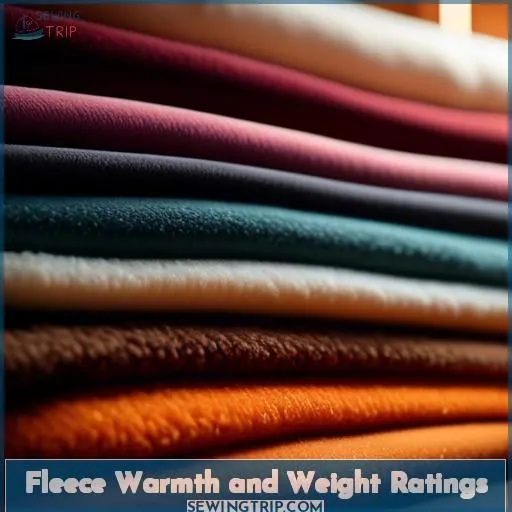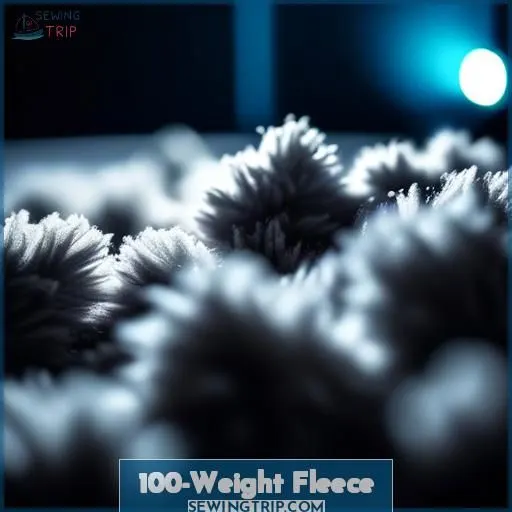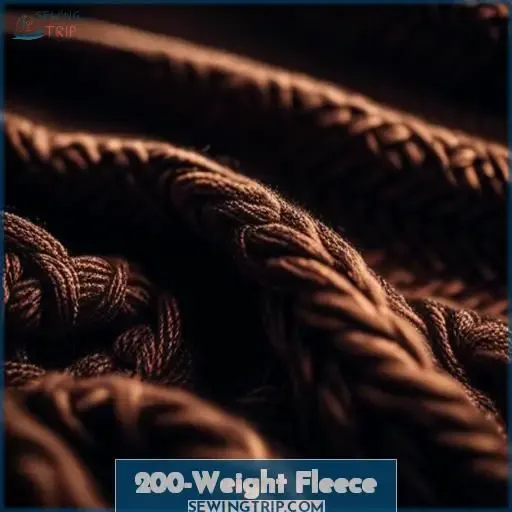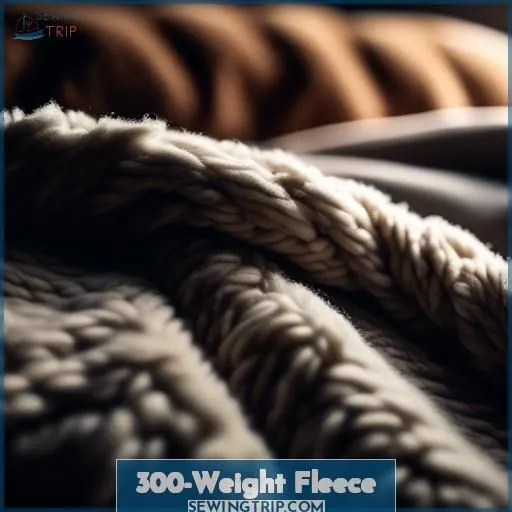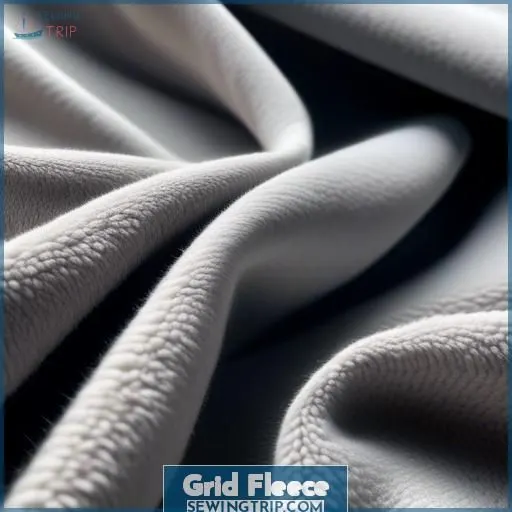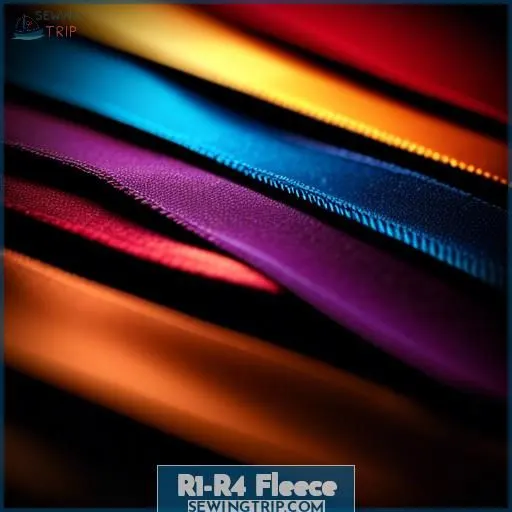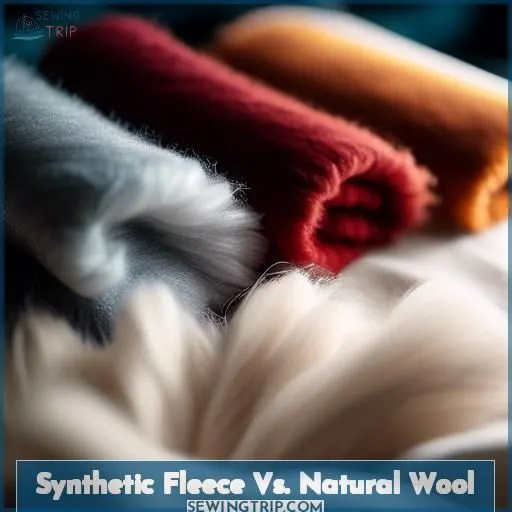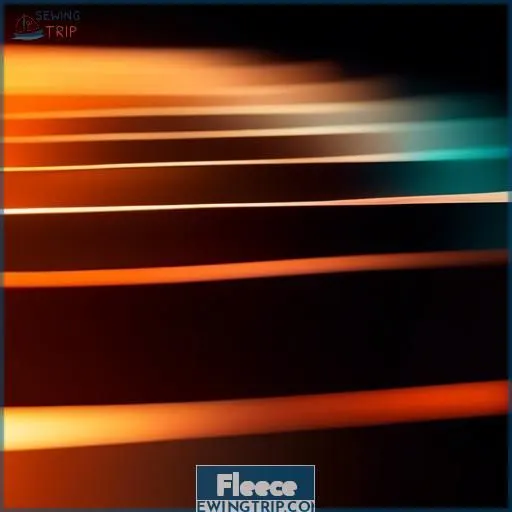This site is supported by our readers. We may earn a commission, at no cost to you, if you purchase through links.

You need to grasp fleece warmth ratings to select the right comfortable layers.
Lighter 100-weight fleece provides breathable insulation for active pursuits.
While 200-weight offers balanced warmth and adaptability.
The thicker 300-weight traps more heat for extreme cold.
Grid fleece enhances airflow.
While Polartec Alpha emulates wool’s insulating properties.
Higher R-values indicate superior thermal performance for the given weight.
Synthetic fleece insulates differently than natural wool fibers.
Want to unravel the mysteries of these comfortable layers for best warmth? Read on for an exhaustive guide.
Table Of Contents
Key Takeaways
- Fleece warmth ratings, indicated by weights such as 100, 200, and 300, are crucial for understanding the insulation capabilities of fleece fabrics, with higher numbers signifying greater warmth.
- Grid fleece is distinguished by its grid-like pattern that enhances breathability, moisture wicking, and air circulation, making it suitable for a variety of outdoor activities.
- Polartec Alpha fleece is a synthetic insulation technology that mimics wool’s insulating properties, offering superior warmth, durability, and environmental performance due to its grid structure and recyclable materials.
- Synthetic fleece and natural wool differ in insulation properties; synthetic fleece is moisture-repellent and lightweight, while wool provides superior warmth ounce-for-ounce and is a sustainable, biodegradable option.
Fleece Warmth and Weight Ratings
Fleece warmth ratings are essential for grasping the insulation capabilities of this widely used synthetic fabric. Fleece thickness, density, and construction critically influence its warmth. Typically, thicker fleece is warmer, as it captures more air and offers enhanced insulation. However, fleece breathability and durability can also affect its warmth ratings.
Fleece weights, such as 100, 200, and 300, signify the fabric’s thickness and warmth level. A higher number denotes a warmer fleece. Grid fleece, for example, promotes air circulation, heat entrapment, and moisture wicking, making it appropriate for diverse conditions.
Fleece types, such as ultralight, lightweight, midweight, and heavyweight, cater to different requirements. Ultralight fleece is lightweight and highly breathable, while heavyweight fleece is loftier and heavier for chilly conditions. Comprehending these ratings and types can assist you in choosing the appropriate fleece for your outdoor activities, ensuring excellent insulation and comfort.
100. Weight Fleece
100-weight fleece, also known as lightweight fleece, is a popular choice for outdoor enthusiasts due to its breathability, versatility, and comfort. This type of fleece is ideal for active layering and is often worn as a baselayer in cool or damp weather. It’s also suitable for use under a rain jacket, as it can absorb condensation without causing the wearer to sweat.
Lightweight fleece is highly breathable, making it perfect for hikers and other individuals who generate a lot of heat. It’s also easy to pack in a backpack, making it a convenient choice for outdoor activities. The fabric is soft, flexible, and lightweight, making it comfortable to wear and layer. It’s often used as an outer layer in cooler weather and when the wearer is less active.
When shopping for lightweight fleece jackets or pullovers, retailers and manufacturers may call it by several different names, including Polartec Thermal Pro Lightweight, 100 Weight Fleece, R1, and TKA 100. Some popular products in this weight class include the Marmot Bridgeport 1/2 zip, which is a versatile and affordable option.
200. Weight Fleece
Explore the realm of 200-weight fleece, the ubiquitous and adaptable type of fleece. This mid-range layer strikes an ideal equilibrium between sturdiness, breathability, and comfort, rendering it an optimal option for diverse outdoor pursuits. Here’s a closer look:
- Durability: 200-weight fleece is robust and can endure the challenges of outdoor adventures without compromising its insulating capabilities.
- Breathability: Despite its thickness, 200-weight fleece is highly breathable, enabling efficient air circulation and heat retention.
- Comfort: This weight class is comfortable and versatile, making it suitable for a broad spectrum of temperatures and activities.
- Value and Style: 200-weight fleece offers excellent value for its performance and comes in a variety of styles, from pullovers to hoodies, ensuring you stay cozy and stylish.
Polartec, a preeminent manufacturer of fleece, categorizes 200-weight fleece as a mid-weight layer, providing a balance between warmth and flexibility. It’s also renowned for its inherent clo rating, which measures thermal resistance and air permeability, making it a superb choice for outdoor enthusiasts.
300. Weight Fleece
Regarding fleece, the fabric’s weight significantly determines its warmth and versatility. Among the weight classes, 300-weight fleece stands out as a midweight option that balances warmth and breathability. This fleece is crafted for cold or extreme weather conditions, making it a prime choice for individuals seeking a cozy layer for outdoor activities or everyday use.
To better comprehend the performance of 300-weight fleece, let’s compare it to other weight classes:
- 100-weight fleece: This lightweight option is highly breathable and works well as a light layering piece for aerobic activities or warmer conditions.
- 200-weight fleece: This mid-weight option is the most popular due to its versatility and ease of layering under hardshells.
- 300-weight fleece: As a midweight option, 300-weight fleece is noticeably loftier and heavier than 100-weight fleece, but it’s less layered and adaptable than 200-weight fleece.
It’s noteworthy that 300-weight fleece’s thickness and weight make it a suitable choice for providing warmth without compromising breathability. This makes it a versatile option for a wide range of activities and conditions.
To further enhance the performance of 300-weight fleece, some manufacturers incorporate grid patterns on the jacket’s inner face, which facilitate air circulation, heat entrapment, and moisture wicking. This feature can improve the fleece’s overall performance in various conditions.
Grid Fleece
Grid fleece, a type of synthetic insulation, is renowned for its unique properties that enhance breathability, moisture wicking, and air circulation.
This type of fleece is often used in high-performance fleece jackets, providing an excellent balance between heat entrapment and moisture management.
Grid fleece is available in various weights, including mid-weight and heavyweight options, which offer different levels of warmth and insulation.
Compared to other fleece types, grid fleece has a higher R-value, indicating better thermal performance.
It’s also suitable for a wide range of outdoor activities, from hiking to skiing, making it a versatile choice for those seeking the best insulation.
Despite its advantages, grid fleece isn’t as warm as heavyweight fleece, and its performance can vary depending on the specific product and its construction.
R1-R4 Fleece
When you’re gearing up for the great outdoors, the R1-R4 fleece series from Patagonia is like a comforting hug from Mother Nature herself. These fleeces are the paragons of layering, each with its own exceptional ability. The R1 is your loyal companion for all seasons, providing fleece breathability that keeps you cool when the trail heats up. Step up to the R2, and you’ve got a thermal ally that harmonizes warmth and fleece comfort without weighing you down.
Now, if you’re venturing into the icy wilderness, the R3 is your sanctuary, plush and cozy, making the chill a mere afterthought. And for those who laugh in the face of gales, the R4 is your windproof shield, with its adaptable defenses standing firm against the howling tempest.
Whether you’re a Patagonia patron or a The North Face enthusiast, these fleeces are a demonstration of fleece durability and versatility. They’re not just layers; they’re your armor in the quest for peak performance and fleece sustainability.
Polartec Alpha Fleece
Polartec Alpha Fleece is a revolutionary insulation technology that has taken the outdoor industry by storm. This innovative material is known for its superior warmth, durability, and environmental performance.
Polartec Alpha Fleece is a unique blend of synthetic fibers that are designed to mimic the natural insulating properties of wool. It features a grid-like structure that allows for efficient heat trapping while also facilitating air circulation and moisture wicking. This combination of properties makes it an excellent choice for a wide range of outdoor activities.
One of the standout characteristics of Polartec Alpha Fleece is its durability. It’s highly resistant to wear and tear, ensuring that your gear stays in top condition even after repeated use. This durability also extends to the environment, as the material is recycled and recyclable, reducing its overall environmental impact.
When it comes to warmth, Polartec Alpha Fleece is a top performer. It offers a high level of insulation without adding excessive weight, making it an ideal choice for those seeking a balance between warmth and portability. Additionally, its moisture-wicking properties help to keep you dry and comfortable, even in challenging weather conditions.
In terms of care, Polartec Alpha Fleece is easy to launder and maintain. It can be machine washed and dried on a low heat setting, making it a convenient option for those with busy lifestyles.
Synthetic Fleece Vs. Natural Wool
Regarding warmth and insulation, synthetic fleece and natural wool possess distinct strengths. Synthetic fleece, crafted from recycled materials such as polyester, boasts a high performance-to-weight ratio. Its moisture-repellent, lightweight, and highly breathable nature makes it a popular choice for outdoor enthusiasts. Conversely, natural wool, including Merino, is a renewable resource with exceptional insulating qualities. Its soft, curled fibers capture body heat and offer a natural, eco-conscious alternative to synthetic insulations.
In terms of comparison, synthetic fleece is typically more cost-efficient, while wool commands a higher price. However, wool appeals to those prioritizing sustainability and eco-friendliness. Both materials exhibit unique advantages and limitations, and the selection often hinges on personal preferences, performance expectations, and budgetary considerations.
Fleece
Shifting focus from the amicable discussion between synthetic fleece and natural wool, let’s explore the realm of fleece. This fabric is more than just a comforting embrace on a cold day; it’s a testament to the brilliance of modern textile engineering. Here’s why:
- Fleece history begins in 1979, a tribute to human innovation. Conceived from the pursuit of lighter, more water-resistant alternatives to wool, fleece swiftly became the preferred choice for outdoor enthusiasts.
- Fleece production entails converting PET into a fabric that’s as soft as a cloud but robust as nails. This process not only imparts fleece with its unique characteristics but also paves the way for fleece sustainability by utilizing recycled materials.
- Fleece durability signifies its ability to withstand both the elements and the washing machine, making it a steadfast companion for any escapade.
- Finally, fleece breathability guarantees comfort without the sensation of being enveloped in a plastic bag. It’s like having your cake and eating it too, but in the context of staying warm and dry!
Wool
Now, let’s explore the realm of wool, our natural substitute for artificial fleece. Wool, derived from Merino sheep, is acclaimed for its soft, coiled fibers that offer exceptional insulation. It’s a renewable asset, a welcome innovation in the fashion industry, and a sustainable option.
Wool has been an essential component of textile production for centuries, but modern methods have enhanced its attributes. Wool production strikes a delicate balance between sheep welfare and environmental stewardship. The process is labor-intensive, but it yields a material that’s warm, breathable, and moisture-wicking.
Wool’s sustainability is a compelling selling point. It’s biodegradable, recyclable, and has a reduced carbon footprint compared to synthetic materials. It’s a conscientious choice for those who seek to make a positive impact.
Wool’s breathability is another advantage. It facilitates air circulation, keeping you cool in the summer and warm in the winter. It’s a versatile material that adapts to diverse weather conditions.
Wool’s moisture management is outstanding. It naturally resists water and dries swiftly. It’s a lifesaver when you’re caught in the rain or engaged in strenuous activity.
In the realm of fleece, wool is a formidable contender. It’s a material that has endured for centuries, refined by time and innovation. It’s a choice that’s not only cozy and comfortable but also sustainable and eco-friendly.
Frequently Asked Questions (FAQs)
How does fleece insulation compare to wool?
You’re right to wonder, fleece may feel cozy but wool’s natural fibers provide far superior warmth ounce-for-ounce. Fleece’s synthetic construction traps heat decently but can’t match the insulating powers of good ol’ sheep’s wool.
What is the difference between 100-weight and 200-weight fleece?
Ye olde 100-weight fleece is lightweight and breathable, ideal for layering during active pursuits. The 200-weight packs more insulating oomph, making it a versatile mid-layer to keep your core toasty on chilly adventures.
Is fleece suitable for cold weather conditions?
You bet! With heavyweight 300-weight fleece, you’ll be nice and toasty even when Jack Frost comes nipping. Just pair it with a windproof layer and your core will stay furnace-like, no icicles allowed.
How does fleece perform in wet conditions?
You’re right to worry – fleece doesn’t fare well in wet conditions. Though it insulates when dry, wetness compromises its warmth and breathability. For rainy hikes, pair fleece layers with a waterproof shell to stay cozy and dry.
Can fleece be used as a standalone insulation layer?
You can, but it’s not ideal as fleece alone lacks the warmth and weather protection of proper insulation. For cooler conditions, layer fleece with a waterproof shell or insulated jacket to stay cozy and dry. A fleece midlayer traps precious body heat while allowing breathability.
Conclusion
Hark, adventurer! With this breakdown of fleece warmth ratings, thou art armed to conquer any chill. Synthetic fleece‘s versatile weights and construction methods offer customized insulation, from breathable 100-weight to furnace-like 300. Contrast fleece’s artificial warmth with nature’s woolly embrace to craft the perfect cold-defying ensemble. Demystify cozy layers with these fleece warmth ratings insights.

